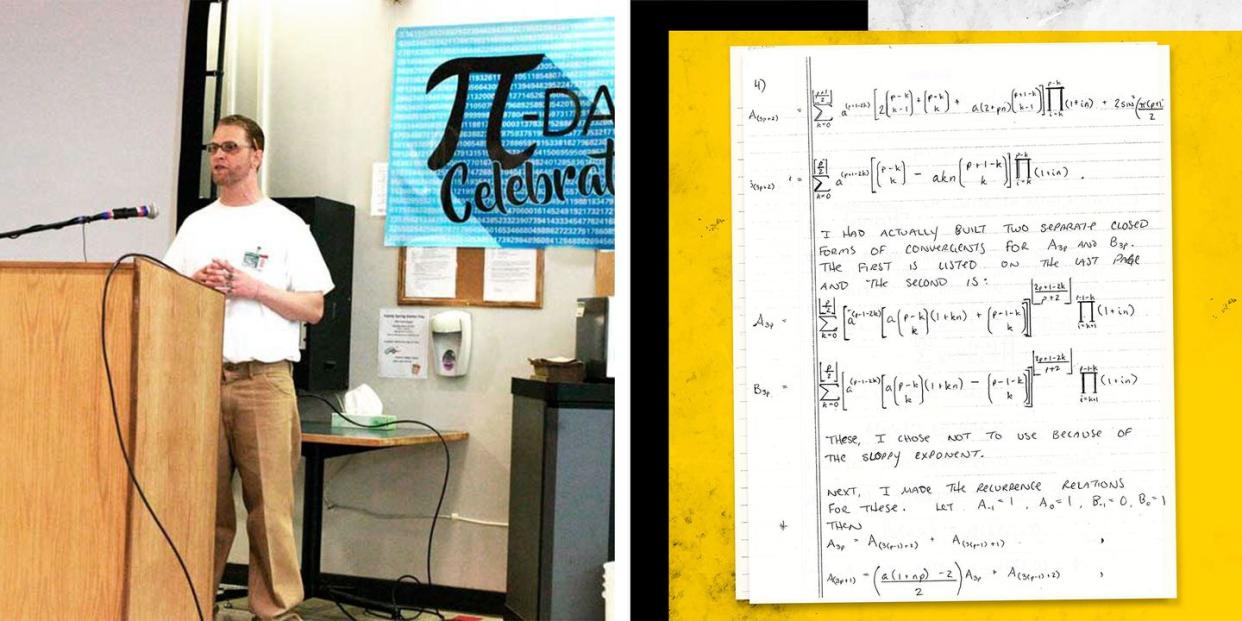This Guy Dropped Out of High School, Went to Prison, Then Came Up With This Number Theory Problem

Last year, Christopher Havens, an inmate serving to 25 years for murder, made headlines as the lead author on an academic paper published in Research in Number Theory. Havens had dropped out of high school, but discovered his fascination with mathematics shortly after starting his 2011 sentence and began teaching himself number theory—the study of integers and their patterns.
An early and continued inspiration for Havens's study was Math Horizons, an undergraduate-level mathematics publication, and its "Problems" section. There, inventive math problems written by students and professors offered challenges for Havens to solve.
Now Math Horizons is printing a problem submitted by Havens:
What is the smallest positive integer y such that 1729y2+1 is a perfect square?
Havens posed this problem in honor of the birthday of Indian mathematician Srinivasa Ramanujan, who was born December 22, 1887. Ramanujan was known for his work in several areas of mathematics, including number theory, and his quick, intuitive way of working with numbers and functions. Havens’s choice of the number 1729 in his problem is a reference to a famous story about Ramanujan. Ramanujan arrived in England in 1914 to work with G.H. Hardy, a number theorist at the University of Cambridge. He suffered severe illness while he was there. (Sadly, he died shortly after returning to India. He was only 32.)
One day Hardy took taxicab number 1729 to the hospital to visit Ramanujan and remarked when he got there that the number 1729 seemed particularly dull. According to Hardy, Ramanujan replied, “No, it’s is a very interesting number; it is the smallest number expressible as the sum of two cubes in two different ways.” Ramanujan had noticed almost instantly that the number 1729 can be written as both 13+123 and 93+103.
➡ Join Pop Mech Pro and get exclusive answers to your burning math questions.
Havens’s problem is an example of Pell’s equation, which is an equation of the form x2−Ny2=1 where N is a whole number that is not a square. Havens is asking when 1729y2+1=x2 has an integer solution for both x and y, so you begin by rearranging the equation so the 1 is by itself. And in both Havens’s question and Pell’s equation, we don’t want any old solutions but pairs of numbers x and y that satisfy the equation where both x and y are integers.
One method for solving Pell’s equation was found by another important Indian mathematician, Bhāskara II, who lived in the 12th century, about 500 years before the English mathematician John Pell whose name is associated with the equations. (In fact, Pell isn’t even the right European man to mistakenly get credit for these equations. Leonhard Euler attributed another contemporary's solution to these equations to Pell, but the name stuck.)
Bhāskara II’s algorithm for solving an equation of the form x2−Ny2=1 is called the chakravala method. It is an iterative process. At its root, the idea is to basically start with a guess of a solution and use it to gradually get closer to the right answer.
Stuff We Love: The Best Math Books
Another algorithm for solving Pell’s equation involves finding the continued fraction representation of the square root of the coefficient (N) in the equation—in this case, 1729. Continued fractions are approximations; as the height of the tower of numerators and denominators grows, the continued fraction approximation gets closer to the irrational number being approximated. The insight of the continued fraction approach to solving Pell’s equation is that when x and y are large, a difference of 1 is relatively small. In other words, numbers that satisfy x2−Ny2=1 are close to being numbers that satisfy x2=Ny2, or (x/y)2=N. Hence looking for a rational number x/y whose square is close to 1729 will help you find numbers x and y that satisfy x2−1729y2=1.
To get from the continued fraction for √1729 to a solution to Pell’s equation, the idea is to take the approximation you get at each step (these rational approximations are called convergents), written as a fraction x/y, and see if it satisfies the equation x2−1729y2=1. This algorithm works, but don’t expect it to go quickly. Grab a beverage, sit back, and continue those fractions!
When you're ready to check your answer, plug 1729 into this Pell's equation calculator.
You Might Also Like

